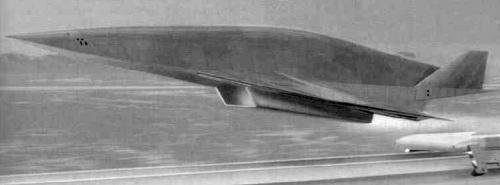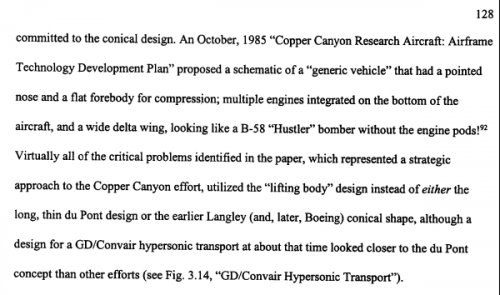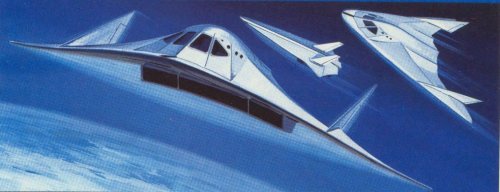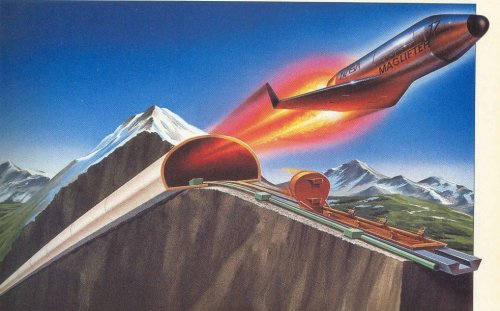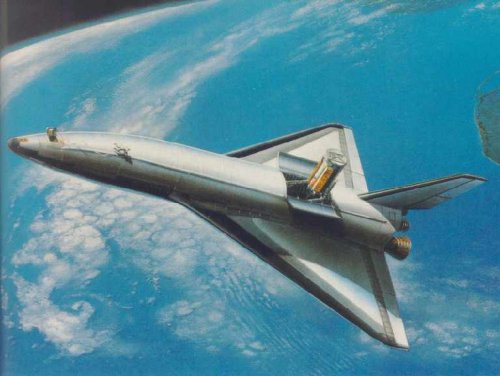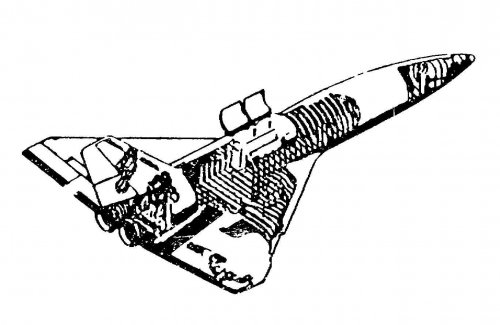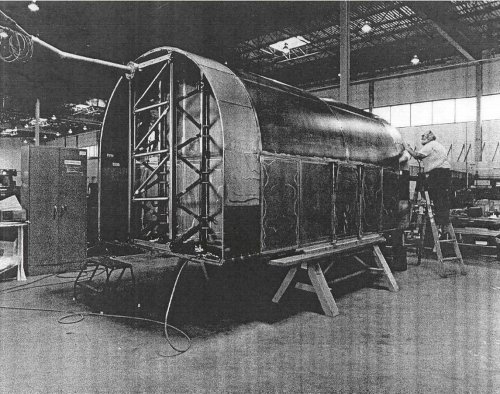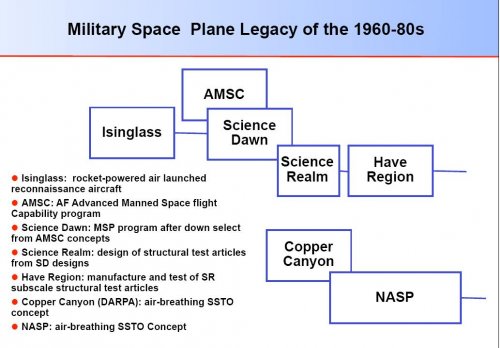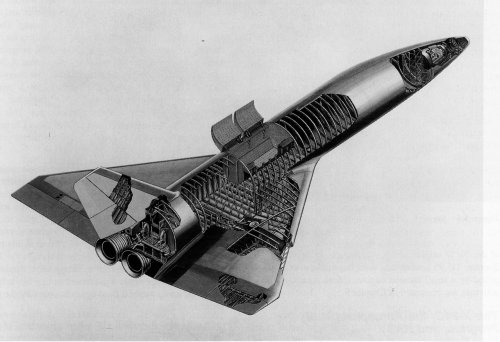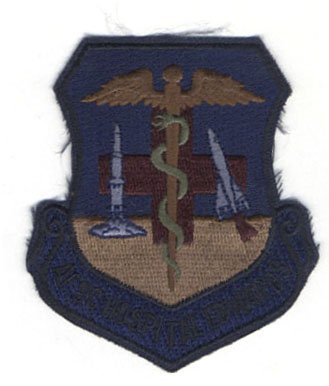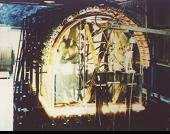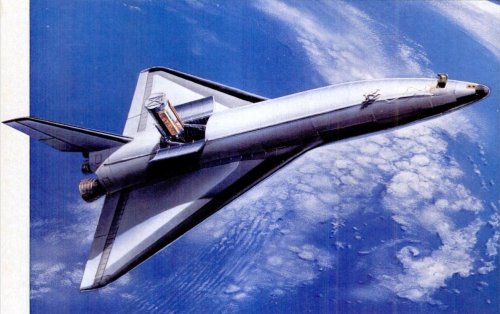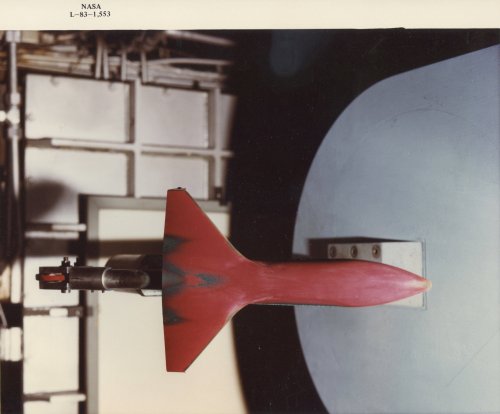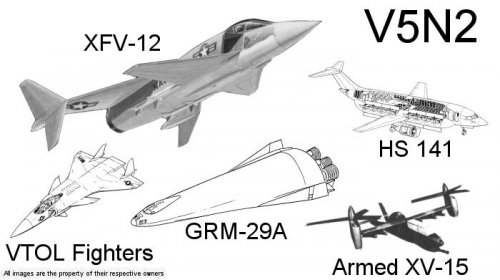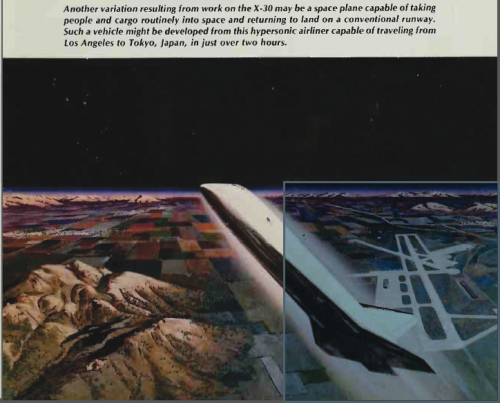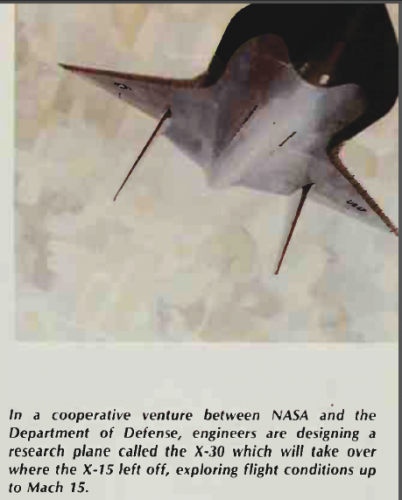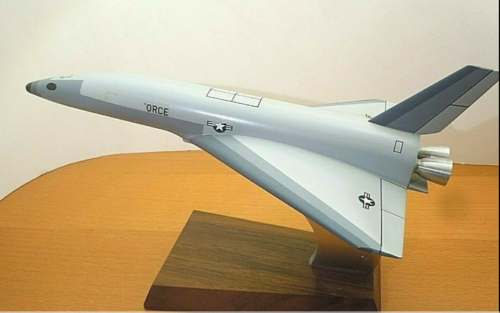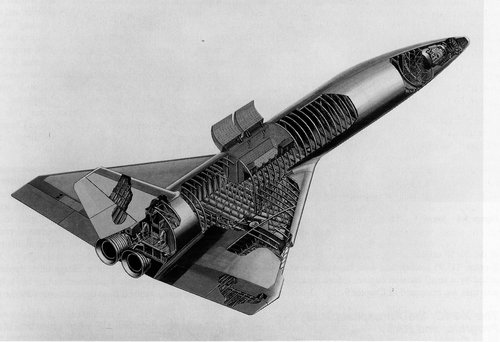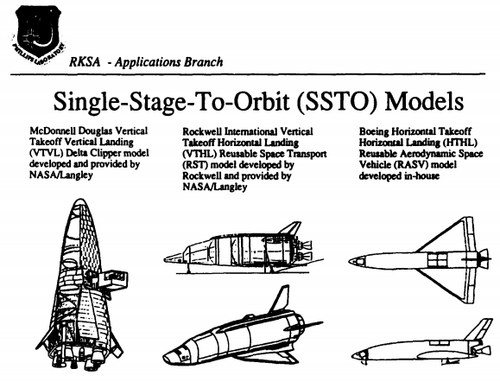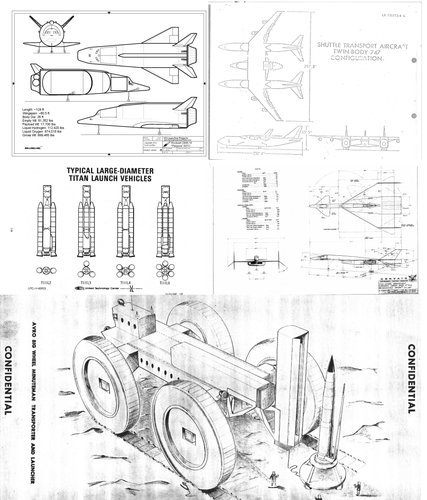You are using an out of date browser. It may not display this or other websites correctly.
You should upgrade or use an alternative browser.
You should upgrade or use an alternative browser.
USAF/NASA RLV programs from the past - AMSCI, Science Dawn, Have Region, etc
- Thread starter flateric
- Start date
I've seen that. I think it was in Aerospace America, but I'm not sure... but I *am* reasonably sure that it's a much-later-than-Copper-Canyon design. I *believe* it's from the mid to late 1990's, I think dealing with the maglaunch concept (magnetic levitation catapult).
- Joined
- 1 April 2006
- Messages
- 11,394
- Reaction score
- 10,302
Scott - Using sleds doesn't make exact timeframe... AFAIK Copper Canyon study at Battelle Labs started not only as a next step after SCIENCE DOWN/SCIENCE REALM/HAVE REGION programs, but main push went when Robert Williams, father of NASP, went in love with Tony duPont hypersonic SSTO concept.
It was ideal in computer calculations to reach orbit, but duPont didn't get into account that real hardware has to use undercarriage and whole bunch of other things aircrafts use to have, and was a 50 000 lbs class vehicle (!) so the only way to launch this was to use sleds. Lockheed's NASP entry was to be sled-launched as well.
Actually, attached is description of Copper Canyon 'generic vehicle'. If Williams liked duPont design, researchers did not.
It was ideal in computer calculations to reach orbit, but duPont didn't get into account that real hardware has to use undercarriage and whole bunch of other things aircrafts use to have, and was a 50 000 lbs class vehicle (!) so the only way to launch this was to use sleds. Lockheed's NASP entry was to be sled-launched as well.
Actually, attached is description of Copper Canyon 'generic vehicle'. If Williams liked duPont design, researchers did not.
Attachments
To my reminds me to the NASA/Ohio State's "unmanned test unit of hipersonic engine"
(1991 -in the center of the first image surrounded by other two designs of waveriders)(source: PM Argentinean edition 3/1991)
The second image corresponds to an artistic conception of the Maglifter
(PM Argentinean edition 1/1996)
(1991 -in the center of the first image surrounded by other two designs of waveriders)(source: PM Argentinean edition 3/1991)
The second image corresponds to an artistic conception of the Maglifter
(PM Argentinean edition 1/1996)
Attachments
British Secret Projects: Hypersonics, Ramjets and Missiles
In his unpublished memoir on ramjet development at Bristol Aero Engines and BSEL, John Lane describes a series of papers he wrote with Robin Jamieson on air-breathing high-speed propulsion systems. Lane makes a very interesting statement: “The papers caused quite a stir when they came out and were ahead of the field. The work was trotted around the US by the author for Rolls Royce in the 1980’s. The author found that the US had not recorded their own work and had forgotten most of it.’
By 1p85 the US had embarked on the Copper Canyon hypersonic studies and the National Aerospace Plane and by 1989 rumours were rife of a hypersonic aircraft operating in the western US. Perhaps like the cavity magnetron, the atomic bomb and that unsung hero of WW2, the strain gauge, Britain’s high-speed propulsion research went across the Atlantic, to live on and even reach the hardware stage.
8)
In his unpublished memoir on ramjet development at Bristol Aero Engines and BSEL, John Lane describes a series of papers he wrote with Robin Jamieson on air-breathing high-speed propulsion systems. Lane makes a very interesting statement: “The papers caused quite a stir when they came out and were ahead of the field. The work was trotted around the US by the author for Rolls Royce in the 1980’s. The author found that the US had not recorded their own work and had forgotten most of it.’
By 1p85 the US had embarked on the Copper Canyon hypersonic studies and the National Aerospace Plane and by 1989 rumours were rife of a hypersonic aircraft operating in the western US. Perhaps like the cavity magnetron, the atomic bomb and that unsung hero of WW2, the strain gauge, Britain’s high-speed propulsion research went across the Atlantic, to live on and even reach the hardware stage.
8)
- Joined
- 1 April 2006
- Messages
- 11,394
- Reaction score
- 10,302
"During the past 25 years the Air Force and NASA have conducted numerous studies and technology programs that could be used to support the development of a reusable launch vehicle, or a military transatmospheric aerospace plane. While none of the programs actually developed an operational vehicle, they provided critical technology and data that could be used to develop a near term aerospace plane.
Isinglass
• Light weight structure and TPS concepts applicable to reusable launch vehicle concepts
Science Dawn
• 3 Military space plane concepts
• In-depth preliminary designs by hand picked design teams
• Upgraded SSME performance, 109 and 115 %, horizontal operation, 2-position nozzle
Have Region
• 3 structural concepts, 2 partial successes, 1 validated concept
• Stainless steel hydrogen tank liner
• Propellant utilization fraction of 0.88
Isinglass was a rocket powered air launched vehicle. In the mid 1960s a follow-on global reconnaissance aircraft was considered. During Isinglass McDonnell developed a new lightweight structure and TPS concept for an air-launched Mach 17+ rocket powered aerospace plane. A structural test articled was designed, built and successfully tested.
The Air Force Advanced Manned Spaceflight Capability (AMSC) study investigated a wide range of reusable launch vehicle concepts and military missions for such a vehicle might do. During the Air Force AMSC program the Air Force Space and Missile Division was looking at a rocket-powered reusable aerospace plane proposed by Boeing called RASV. The RASV was initially formulated for NASA as a candidate to replace the Space Shuttle. The RASV used a hot structure approach Boeing derived from their Dyna Soar program in the late 1950s and early 1960s. Isinglass and RASV provided the bases for further investigation of a military aerospace plane by the Air Force.
At the conclusion of the Air Force AMSC program, the Air Force initiated Science Dawn to determine the technical feasibility of a military aerospace plane. Science Dawn was an in depth technical feasibility study focused on rocket powered aerospace plane concepts by Lockheed Skunk Works, McDonnell, and Boeing. Rocketdyne, Air Products, and the AF SAC supported the three primary contractors. Three airframe contractors plus Rocketdyne and Air Products participated in the program.
Science Dawn numbers:
10,000-lb Payload to Polar Orbit from Grand Forks
1,227,000 lb Assisted SSTO
At the conclusion of Science Dawn it was determined that while propulsion and the other key technologies were sufficiently developed, structures and TPS needed further development to reduce risk. Have Region was initiated to address the structures, TPS issues. While Have Region was progressing, the Air Force, NASA and DARPA initiated the National AeroSpace Plane program (NASP).
During Have Region, a structural concept was demonstrated that could provide the propellant utilization fractions needed for
the two stage-to-orbit aerospace plane. The contractors investigated using the Space Shuttle main engine (SSME) for their design concepts. Rocketdyne concluded that the modification needed for horizontal operations plus the addition of a two position nozzle were achievable with relatively low risk. An additional 20 years of experience with the SSME engine since Science Dawn has proven that the engine is reliable.
During Have Region large scale structural test articles were built and tested. Of three test articles built only one was validated. The validated structural test article was a hot structure concept. The test article contained over 90% of the parts that would have gone into the flight article. Figure shows the Boeing hot structure test article.
The Boeing test article was a half scale representative section of the vehicle containing the wing carry through structure, propellant tank with flat bulkheads, and the engine thrust attachment structure. The actual weight of the test article was lighter then predicted by the design code.
The people that conduced Isinglass, Science Dawn and Have Region all had a record of successful flight projects. Norm Nelson, program manager of Have Blue, headed the Lockheed Skunk Works team. Larry Smith, Chief Engineer on F-15, F-18, and AV-8,
headed the McDonnell team. Andy Hepler, structural lead on Dyna Soar and program manager on RASV, headed the Boeing team. Each team had corporate support at the Corporate Presidential level. Resources were provided as required by the program managers."
Adopted from AIAA 2004-3731
The Formulation of a Near Term Stepping Stone to a Low Cost Earth-to-Orbit Transportation System Based on Legacy Technology
Ramon L. Chase, ANSER
Isinglass
• Light weight structure and TPS concepts applicable to reusable launch vehicle concepts
Science Dawn
• 3 Military space plane concepts
• In-depth preliminary designs by hand picked design teams
• Upgraded SSME performance, 109 and 115 %, horizontal operation, 2-position nozzle
Have Region
• 3 structural concepts, 2 partial successes, 1 validated concept
• Stainless steel hydrogen tank liner
• Propellant utilization fraction of 0.88
Isinglass was a rocket powered air launched vehicle. In the mid 1960s a follow-on global reconnaissance aircraft was considered. During Isinglass McDonnell developed a new lightweight structure and TPS concept for an air-launched Mach 17+ rocket powered aerospace plane. A structural test articled was designed, built and successfully tested.
The Air Force Advanced Manned Spaceflight Capability (AMSC) study investigated a wide range of reusable launch vehicle concepts and military missions for such a vehicle might do. During the Air Force AMSC program the Air Force Space and Missile Division was looking at a rocket-powered reusable aerospace plane proposed by Boeing called RASV. The RASV was initially formulated for NASA as a candidate to replace the Space Shuttle. The RASV used a hot structure approach Boeing derived from their Dyna Soar program in the late 1950s and early 1960s. Isinglass and RASV provided the bases for further investigation of a military aerospace plane by the Air Force.
At the conclusion of the Air Force AMSC program, the Air Force initiated Science Dawn to determine the technical feasibility of a military aerospace plane. Science Dawn was an in depth technical feasibility study focused on rocket powered aerospace plane concepts by Lockheed Skunk Works, McDonnell, and Boeing. Rocketdyne, Air Products, and the AF SAC supported the three primary contractors. Three airframe contractors plus Rocketdyne and Air Products participated in the program.
Science Dawn numbers:
10,000-lb Payload to Polar Orbit from Grand Forks
1,227,000 lb Assisted SSTO
At the conclusion of Science Dawn it was determined that while propulsion and the other key technologies were sufficiently developed, structures and TPS needed further development to reduce risk. Have Region was initiated to address the structures, TPS issues. While Have Region was progressing, the Air Force, NASA and DARPA initiated the National AeroSpace Plane program (NASP).
During Have Region, a structural concept was demonstrated that could provide the propellant utilization fractions needed for
the two stage-to-orbit aerospace plane. The contractors investigated using the Space Shuttle main engine (SSME) for their design concepts. Rocketdyne concluded that the modification needed for horizontal operations plus the addition of a two position nozzle were achievable with relatively low risk. An additional 20 years of experience with the SSME engine since Science Dawn has proven that the engine is reliable.
During Have Region large scale structural test articles were built and tested. Of three test articles built only one was validated. The validated structural test article was a hot structure concept. The test article contained over 90% of the parts that would have gone into the flight article. Figure shows the Boeing hot structure test article.
The Boeing test article was a half scale representative section of the vehicle containing the wing carry through structure, propellant tank with flat bulkheads, and the engine thrust attachment structure. The actual weight of the test article was lighter then predicted by the design code.
The people that conduced Isinglass, Science Dawn and Have Region all had a record of successful flight projects. Norm Nelson, program manager of Have Blue, headed the Lockheed Skunk Works team. Larry Smith, Chief Engineer on F-15, F-18, and AV-8,
headed the McDonnell team. Andy Hepler, structural lead on Dyna Soar and program manager on RASV, headed the Boeing team. Each team had corporate support at the Corporate Presidential level. Resources were provided as required by the program managers."
Adopted from AIAA 2004-3731
The Formulation of a Near Term Stepping Stone to a Low Cost Earth-to-Orbit Transportation System Based on Legacy Technology
Ramon L. Chase, ANSER
Attachments
- Joined
- 1 April 2006
- Messages
- 11,394
- Reaction score
- 10,302
More complete list of DoD/USAF RLV programs to 1992 from ANSER paper
A Near Term Reusable Launch Vehicle Strategy
Ramon L. Chase, Warren Greczyn, Leon McKinney
February 2003
1965-70 Air Force Aerospace plane and DynaSoar programs
1965-68 CIA Isinglass program
1975-78 NASA and Air Force single stage to orbit studies
1978-79 Air Force Military Crews in Space study
1979-80 AF HQ (RDSL) mission analysis and cost benefit studies
1980-82 Air Force Advanced Manned Space-Flight Capability study
1980-82 Air Force Transatmospheric Vehicle study
1982-84 Air HQ (RDSL) Science Dawn program
1984-85 Air Force Science Realm program
1984-86 DARPA Copper Canyon study
1986-88 Air Force Have Region program
1986-92 DOD-NASA National AeroSpace Plane (NASP) program
A Near Term Reusable Launch Vehicle Strategy
Ramon L. Chase, Warren Greczyn, Leon McKinney
February 2003
1965-70 Air Force Aerospace plane and DynaSoar programs
1965-68 CIA Isinglass program
1975-78 NASA and Air Force single stage to orbit studies
1978-79 Air Force Military Crews in Space study
1979-80 AF HQ (RDSL) mission analysis and cost benefit studies
1980-82 Air Force Advanced Manned Space-Flight Capability study
1980-82 Air Force Transatmospheric Vehicle study
1982-84 Air HQ (RDSL) Science Dawn program
1984-85 Air Force Science Realm program
1984-86 DARPA Copper Canyon study
1986-88 Air Force Have Region program
1986-92 DOD-NASA National AeroSpace Plane (NASP) program
Attachments
- Joined
- 1 April 2006
- Messages
- 11,394
- Reaction score
- 10,302
Following add-ons are taken from Tuomas Narvainen web-page at http://personal.inet.fi/cool/foxfour/black/index.html
Science Dawn
A classified program, based on a 1982 Boeing proposal, to build a sled-launched horizontal-takeoff / horizontal-landing single stage to orbit (SSTO) launch vehicle. Three hand-picked design teams participated. By 1984 it had become clear that horizontal takeoff was inappropriate use of rocket power, and the program was abandoned.
The Boeing Reusable AeroSpace Vehicle (RASV) comprised a ground-based sled to accelerate the aircraft to takeoff speed on a conventional runway, and a delta-winged, piloted orbital vehicle. The RASV was designed to be constructed of conventional refractory metals such as titanium and Rene-41, with the cryogenic liquid hydrogen and liquid oxygen propellants contained withing the "hot structure" wing acting as a heat sink to cool the airframe and reduce weight (by largely eliminating heavy insulation materials). Powered by two modified Space Shuttle Main Engines, the RASV attracted considerable attention from the Air Force, which invested $3 million in the project for technology development in the early 1980s. In December 1982 Boeing chairman T.A. Wilson gave the RASV effort a go-ahead to build a $11.4 billion half scale prototype vehicle. As it turned out, both the USAF and Boeing funds allocated for the RASV went to the development and redesign work of the B-2 bomber instead.
Science Realm
The program was initiated in 1984 as a follow-on to Science Dawn. In contrast to Science Dawn, which stressed horizontal takeoff, Science Realm investigated vertical takeoff SSTO designs, capitalizing on the high thrust-to-weight ratio of a rocket engine.
Have Region
In 1986 Science Realm was followed by the Have Region program, to complement the ongoing air-breathing work in the NASP program. Under the program three prototype lightweight structures were fabricated primarily from exotic metals to evaluate near-term flight readiness. Although the results were generally promising, in 1988 it was concluded that the materials developed for the NASP were more promising.
Copper Canyon
In June 1983 DARPA initiated the classified Copper Canyon program to investigate the potential military applications of air-breathing hypersonic and single stage to orbit vehicles and technologies. Funded with a tiny seed of $6 million for 1983, by 1985 that had risen into hundreds of millions of dollars. Concepts for future hypersonic and orbital vehicles included high speed cruise missiles, two stage to orbit satellite launchers, high-Mach bombers and reconaissance aircraft. In mid-1985 the Transatmospheric Vehicle (TAV) group at the USAF Aeronautical Systems Center became aware of the work being done under Copper Canyon. The TAV studies and contractor designs had concentrated on rocket-based single stage to orbit vehicles rather than the air-breathing vehicles envisioned by Copper Canyon. Soon both groups were discussing a multibillion dollar effort to produce a single stage to orbit aircraft in collaboration with NASA and other DOD agencies to reduce the cost of access to space. During October 1985 the USAF ASC launched the Advanced Aerospace Vehicle (AAV) program to develop advanced hypersonic military aircraft.
Science Dawn
A classified program, based on a 1982 Boeing proposal, to build a sled-launched horizontal-takeoff / horizontal-landing single stage to orbit (SSTO) launch vehicle. Three hand-picked design teams participated. By 1984 it had become clear that horizontal takeoff was inappropriate use of rocket power, and the program was abandoned.
The Boeing Reusable AeroSpace Vehicle (RASV) comprised a ground-based sled to accelerate the aircraft to takeoff speed on a conventional runway, and a delta-winged, piloted orbital vehicle. The RASV was designed to be constructed of conventional refractory metals such as titanium and Rene-41, with the cryogenic liquid hydrogen and liquid oxygen propellants contained withing the "hot structure" wing acting as a heat sink to cool the airframe and reduce weight (by largely eliminating heavy insulation materials). Powered by two modified Space Shuttle Main Engines, the RASV attracted considerable attention from the Air Force, which invested $3 million in the project for technology development in the early 1980s. In December 1982 Boeing chairman T.A. Wilson gave the RASV effort a go-ahead to build a $11.4 billion half scale prototype vehicle. As it turned out, both the USAF and Boeing funds allocated for the RASV went to the development and redesign work of the B-2 bomber instead.
Science Realm
The program was initiated in 1984 as a follow-on to Science Dawn. In contrast to Science Dawn, which stressed horizontal takeoff, Science Realm investigated vertical takeoff SSTO designs, capitalizing on the high thrust-to-weight ratio of a rocket engine.
Have Region
In 1986 Science Realm was followed by the Have Region program, to complement the ongoing air-breathing work in the NASP program. Under the program three prototype lightweight structures were fabricated primarily from exotic metals to evaluate near-term flight readiness. Although the results were generally promising, in 1988 it was concluded that the materials developed for the NASP were more promising.
Copper Canyon
In June 1983 DARPA initiated the classified Copper Canyon program to investigate the potential military applications of air-breathing hypersonic and single stage to orbit vehicles and technologies. Funded with a tiny seed of $6 million for 1983, by 1985 that had risen into hundreds of millions of dollars. Concepts for future hypersonic and orbital vehicles included high speed cruise missiles, two stage to orbit satellite launchers, high-Mach bombers and reconaissance aircraft. In mid-1985 the Transatmospheric Vehicle (TAV) group at the USAF Aeronautical Systems Center became aware of the work being done under Copper Canyon. The TAV studies and contractor designs had concentrated on rocket-based single stage to orbit vehicles rather than the air-breathing vehicles envisioned by Copper Canyon. Soon both groups were discussing a multibillion dollar effort to produce a single stage to orbit aircraft in collaboration with NASA and other DOD agencies to reduce the cost of access to space. During October 1985 the USAF ASC launched the Advanced Aerospace Vehicle (AAV) program to develop advanced hypersonic military aircraft.
antigravite
ACCESS: Top Secret
- Joined
- 25 April 2008
- Messages
- 836
- Reaction score
- 258
- Joined
- 1 April 2006
- Messages
- 11,394
- Reaction score
- 10,302
...program called HAVE REGION executed in the late 1980’s. HAVE REGION fabricated and tested major airframe cross sections of high propellant mass fraction RLV’s. The airframe cross sections were then tested using liquid nitrogen in the propellant tanks and quartz lamps on the outside to simulate multiple ascent and orbital reentry mission cycles respectively. Throughout the test, dynamic mechanical loads representative of the ascent and descent environment were imposed on the test structure.
Boeing, Lockheed-Martin, and McDonnell Douglas built and tested airframe cross sections at scales ranging from 40 to 100% of full scale and at costs ranging from $11 to 15 million.
from AFRL-WS 07-0646, Fully Reusable Access to Space Technology FAST
another RASV artist's impression from Popular Mechanics
Boeing Have Region test article color photo
Attachments
- Joined
- 6 August 2007
- Messages
- 3,894
- Reaction score
- 5,978
flateric said:During October 1985 the USAF ASC launched the Advanced Aerospace Vehicle (AAV) program to develop advanced hypersonic military aircraft.
100 internets to the author. I have to dig around quite a bit to find it, but I do have an interesting public reference to this program from several years later.
- Joined
- 27 December 2005
- Messages
- 17,748
- Reaction score
- 26,421
Tuomas Narvainen is forum member Meteorit.
Tuomasn
ACCESS: Secret
- Joined
- 5 January 2006
- Messages
- 477
- Reaction score
- 358
quellish said:I have to dig around quite a bit to find it, but I do have an interesting public reference to this program from several years later.
At least one reference is The Hypersonic Revolution. Volume II. From Scramjet to the National Aero-Space Plane (1964-1986) p.1362. As I said before I'm working on better versions of those short program descriptions - I'll try to hurry up a bit as I think they are somewhat outdated and badly worded.
Tuomasn
ACCESS: Secret
- Joined
- 5 January 2006
- Messages
- 477
- Reaction score
- 358
Here are updated versions of most of the program descriptions, I'll update my homepage once I have RASV and ALSV figured out also. Comments and corrections are welcome.
Advanced Military Space Flight Capability (AMSC)
Initiated by AFSC with one-year study contracts awarded to General Dynamics and Rockwell in 1981. Technology studies of small manned spacecraft based on two generic launch concepts: subsonic air launch and "staged" ground launch. Replaced by the Advanced Military Space Technology (AMST) program with a contract awarded to Boeing in January 1984 to determine key aerodynamic and performance parameters associated with air-launching a so-called AMST/TAV orbiter from a carrier aircraft.
Transatmospheric Vehicle (TAV)
Program begun in mid-1982. Stanley Tremaine coined the term “Transatmospheric Vehicle”, as the craft should be able to operate with equal efficiency both within the atmosphere and in space and be capable of transitioning from space into the atmosphere and back. Phase I of the TAV study began in May 1983 with Battelle Laboratories working with Boeing, General Dynamics, Lockheed, and Rockwell. McDonnell-Douglas submitted its own unsolicited TAV proposal. Phase I ended in December 1983 and resulted in 14 vehicle concepts. Phase II started in August 1984 with a twelve-month contract to Science Applications. In Phase II selected industry concepts were evaluated against alternative solutions such as advanced aircraft and the necessary technologies were further examined with emphasis on determining the military effectiveness of a TAV. The TAV was expected to be the size of a small airliner with a gross liftoff weight of 1 to 1.5 million lbs and using up-rated SSMEs for propulsion in the first generation. A TAV Project office was established in December 1984 under the direction of Lt Col Vince Rausch. By early 1986 the TAV program had been replaced by NASP with the entire TAV staff transferring into the NASP JPO.
Science Dawn
A classified program begun in 1982 to determine the technical feasibility of a military aerospace plane. Requirements were for a sled-launched horizontal-takeoff / horizontal-landing single stage to orbit (SSTO) launch vehicle powered by a modified SSME with a two-position nozzle. Dry mass was to be 100,000-150,000 lb, takeoff mass 1,2-1,5 million lb with a 10,000 lb payload to a polar orbit from Grand Forks AFB. AMSC concepts from Boeing, Lockheed and McDonnell Douglas were hand-picked for further development with Rocketdyne and Air Products as propulsion contractors. The Boeing concept was apparently their RASV vehicle. The McDonnell Douglas proposal, possibly GRM-29A, had a down- pointing SSME in the nose to cater for the runway requirements, whereas Lockheed used a ramped takeoff with two solid boosters. By 1984 it had become clear that horizontal takeoff was inappropriate use of rocket power, and the program was superseded by Science Realm.
Science Realm
The program was initiated in 1984 as a follow-on to Science Dawn. In contrast to Science Dawn, which stressed horizontal takeoff, Science Realm investigated vertical takeoff SSTO designs, capitalizing on the high thrust-to-weight ratio of a rocket engine. During the program structural test articles were designed based on Science Dawn designs. The cost of Science Dawn and Science Realm together was about $20 million.
Have Region
In 1986 Science Realm was followed by the Have Region program, to complement the ongoing air-breathing work in the NASP program. Main goal was to further develop structures and TPS to reduce risk. Under the program three prototype lightweight structures in scales from 40 to 100% were fabricated from exotic metals, primarily titanium and high-temperature superalloys, to evaluate near-term flight readiness. In tests the Boeing concept was validated and the built but untested Lockheed and McDonnell Douglas designs were classified as partial successes. The test articles were within 3% of required SSTO design weights. Regardless in 1988 it was concluded that the materials developed for NASP were more promising. Total cost of Have Region was around $40 million.
Copper Canyon and NASP
In June 1983 DARPA initiated the classified Copper Canyon program to investigate the potential military applications of air-breathing hypersonic and single stage to orbit vehicles and technologies with Vince Rausch as project director. Tony DuPont’s initial design from 1983 originated from a NASA study into engine cycles and was a 50,000 lb “F-15 sized“ aircraft. Funded with $6 million for 1983, with Battelle Laboratories doing the main work and initial contracts for airframe work to Boeing, Lockheed and General Dynamics, and propulsion work to Marquardt and GASL. In mid-1985 the TAV group at the USAF Aeronautical Systems Center became aware of the work being done under Copper Canyon. The TAV studies and contractor designs had concentrated on rocket-based single stage to orbit vehicles rather than the air-breathing vehicles envisioned by Copper Canyon. Soon both groups were discussing a multibillion dollar effort to produce a single stage to orbit aircraft in collaboration with NASA and other DOD agencies to reduce the cost of access to space. In October 1985 the USAF ASC launched the Advanced Aerospace Vehicle (AAV) program to develop advanced hypersonic military aircraft. In December 1985 the National Aerospace Plane (NASP) program was born, a civilian led national effort to develop a single stage to orbit vehicle. NASP JPO was established in January 1986, and president Reagan announced the NASP in his first state of the union address in February 1986. Copper Canyon constituted Phase I of NASP program.
The objective of NASP was to develop two flight vehicles with air breathing propulsion from takeoff to orbit. Rocket engines were to be used for final orbital insertion and orbital maneuvers. Airframe, engine module and test facility RFPs were sent out in November 1985. In April 1986 the first design contracts for the NASP program were awarded. Contractors included Boeing, Lockheed, McDonnell Douglas, General Dynamics and Rockwell, with Pratt & Whitney and General Electric for propulsion research. Rocketdyne later contributed to NASP under its own funding. In October 1987, following Phase 2A evaluation, Lockheed and Boeing were dropped from the NASP program, alongside General Electric.
Throughout the NASP program the Department of Defense had an 80% share of all money spent on the program. In 1989, during his first week of office as the Secretary of Defense, Richard Cheney terminated the DoD NASP effort. A program review by the National Space Council recommended extending Phase 2 to 1993. In 1991, the National Team program approach combined the resources of the five contractors in a joint-venture partnership to develop a single X-30 concept. Upon completion of the Phase 2D technology development portion in 1993, the technological maturity was deemed not to be at the level required to justify a $15 billion investment to develop two X-30 aircraft in Phase 3, and the NASP was finally cancelled in May 1993.
Sources:
The Hypersonic Revolution. Volume II. From Scramjet to the National Aero-Space Plane (1964-1986). Richard P. Hallion (Ed.), USAF Aeronautical Systems Division, 1987.
The Hypersonic Revolution. Volume III. The Quest for the Orbital Jet: The National Aero-Space Plane Program (1983-1995). Larry Schweikart, Air Force History and Museums Program, 1998.
A Near Term Reusable Launch Vehicle Strategy (http://chapters.nss.org/ny/LongIsland/articles/ANSER.PDF)
http://fas.org/irp/mystery/index.html
http://www.netwrx1.com/skunk-works/v04.n036
(Aviation Week and Space Technology, 11 October 1993, p.49)
http://www.secretprojects.co.uk/forum/index.php/topic,315.0.html
Advanced Military Space Flight Capability (AMSC)
Initiated by AFSC with one-year study contracts awarded to General Dynamics and Rockwell in 1981. Technology studies of small manned spacecraft based on two generic launch concepts: subsonic air launch and "staged" ground launch. Replaced by the Advanced Military Space Technology (AMST) program with a contract awarded to Boeing in January 1984 to determine key aerodynamic and performance parameters associated with air-launching a so-called AMST/TAV orbiter from a carrier aircraft.
Transatmospheric Vehicle (TAV)
Program begun in mid-1982. Stanley Tremaine coined the term “Transatmospheric Vehicle”, as the craft should be able to operate with equal efficiency both within the atmosphere and in space and be capable of transitioning from space into the atmosphere and back. Phase I of the TAV study began in May 1983 with Battelle Laboratories working with Boeing, General Dynamics, Lockheed, and Rockwell. McDonnell-Douglas submitted its own unsolicited TAV proposal. Phase I ended in December 1983 and resulted in 14 vehicle concepts. Phase II started in August 1984 with a twelve-month contract to Science Applications. In Phase II selected industry concepts were evaluated against alternative solutions such as advanced aircraft and the necessary technologies were further examined with emphasis on determining the military effectiveness of a TAV. The TAV was expected to be the size of a small airliner with a gross liftoff weight of 1 to 1.5 million lbs and using up-rated SSMEs for propulsion in the first generation. A TAV Project office was established in December 1984 under the direction of Lt Col Vince Rausch. By early 1986 the TAV program had been replaced by NASP with the entire TAV staff transferring into the NASP JPO.
Science Dawn
A classified program begun in 1982 to determine the technical feasibility of a military aerospace plane. Requirements were for a sled-launched horizontal-takeoff / horizontal-landing single stage to orbit (SSTO) launch vehicle powered by a modified SSME with a two-position nozzle. Dry mass was to be 100,000-150,000 lb, takeoff mass 1,2-1,5 million lb with a 10,000 lb payload to a polar orbit from Grand Forks AFB. AMSC concepts from Boeing, Lockheed and McDonnell Douglas were hand-picked for further development with Rocketdyne and Air Products as propulsion contractors. The Boeing concept was apparently their RASV vehicle. The McDonnell Douglas proposal, possibly GRM-29A, had a down- pointing SSME in the nose to cater for the runway requirements, whereas Lockheed used a ramped takeoff with two solid boosters. By 1984 it had become clear that horizontal takeoff was inappropriate use of rocket power, and the program was superseded by Science Realm.
Science Realm
The program was initiated in 1984 as a follow-on to Science Dawn. In contrast to Science Dawn, which stressed horizontal takeoff, Science Realm investigated vertical takeoff SSTO designs, capitalizing on the high thrust-to-weight ratio of a rocket engine. During the program structural test articles were designed based on Science Dawn designs. The cost of Science Dawn and Science Realm together was about $20 million.
Have Region
In 1986 Science Realm was followed by the Have Region program, to complement the ongoing air-breathing work in the NASP program. Main goal was to further develop structures and TPS to reduce risk. Under the program three prototype lightweight structures in scales from 40 to 100% were fabricated from exotic metals, primarily titanium and high-temperature superalloys, to evaluate near-term flight readiness. In tests the Boeing concept was validated and the built but untested Lockheed and McDonnell Douglas designs were classified as partial successes. The test articles were within 3% of required SSTO design weights. Regardless in 1988 it was concluded that the materials developed for NASP were more promising. Total cost of Have Region was around $40 million.
Copper Canyon and NASP
In June 1983 DARPA initiated the classified Copper Canyon program to investigate the potential military applications of air-breathing hypersonic and single stage to orbit vehicles and technologies with Vince Rausch as project director. Tony DuPont’s initial design from 1983 originated from a NASA study into engine cycles and was a 50,000 lb “F-15 sized“ aircraft. Funded with $6 million for 1983, with Battelle Laboratories doing the main work and initial contracts for airframe work to Boeing, Lockheed and General Dynamics, and propulsion work to Marquardt and GASL. In mid-1985 the TAV group at the USAF Aeronautical Systems Center became aware of the work being done under Copper Canyon. The TAV studies and contractor designs had concentrated on rocket-based single stage to orbit vehicles rather than the air-breathing vehicles envisioned by Copper Canyon. Soon both groups were discussing a multibillion dollar effort to produce a single stage to orbit aircraft in collaboration with NASA and other DOD agencies to reduce the cost of access to space. In October 1985 the USAF ASC launched the Advanced Aerospace Vehicle (AAV) program to develop advanced hypersonic military aircraft. In December 1985 the National Aerospace Plane (NASP) program was born, a civilian led national effort to develop a single stage to orbit vehicle. NASP JPO was established in January 1986, and president Reagan announced the NASP in his first state of the union address in February 1986. Copper Canyon constituted Phase I of NASP program.
The objective of NASP was to develop two flight vehicles with air breathing propulsion from takeoff to orbit. Rocket engines were to be used for final orbital insertion and orbital maneuvers. Airframe, engine module and test facility RFPs were sent out in November 1985. In April 1986 the first design contracts for the NASP program were awarded. Contractors included Boeing, Lockheed, McDonnell Douglas, General Dynamics and Rockwell, with Pratt & Whitney and General Electric for propulsion research. Rocketdyne later contributed to NASP under its own funding. In October 1987, following Phase 2A evaluation, Lockheed and Boeing were dropped from the NASP program, alongside General Electric.
Throughout the NASP program the Department of Defense had an 80% share of all money spent on the program. In 1989, during his first week of office as the Secretary of Defense, Richard Cheney terminated the DoD NASP effort. A program review by the National Space Council recommended extending Phase 2 to 1993. In 1991, the National Team program approach combined the resources of the five contractors in a joint-venture partnership to develop a single X-30 concept. Upon completion of the Phase 2D technology development portion in 1993, the technological maturity was deemed not to be at the level required to justify a $15 billion investment to develop two X-30 aircraft in Phase 3, and the NASP was finally cancelled in May 1993.
Sources:
The Hypersonic Revolution. Volume II. From Scramjet to the National Aero-Space Plane (1964-1986). Richard P. Hallion (Ed.), USAF Aeronautical Systems Division, 1987.
The Hypersonic Revolution. Volume III. The Quest for the Orbital Jet: The National Aero-Space Plane Program (1983-1995). Larry Schweikart, Air Force History and Museums Program, 1998.
A Near Term Reusable Launch Vehicle Strategy (http://chapters.nss.org/ny/LongIsland/articles/ANSER.PDF)
http://fas.org/irp/mystery/index.html
http://www.netwrx1.com/skunk-works/v04.n036
(Aviation Week and Space Technology, 11 October 1993, p.49)
http://www.secretprojects.co.uk/forum/index.php/topic,315.0.html
- Joined
- 29 July 2009
- Messages
- 1,769
- Reaction score
- 2,476
Dynoman said:Full powerpoint available at nianet.org
Where?
XP67_Moonbat
ACCESS: Top Secret
- Joined
- 16 January 2008
- Messages
- 2,271
- Reaction score
- 543
Hey the McD design is GRM-29A, isn't it?
Yup. The Boeing design is clearly the RASV; the Lockheed design seems... unfinished.
Meteorit said:Copper Canyon and NASP
Contractors included Boeing, Lockheed, McDonnell Douglas, General Dynamics and Rockwell, with Pratt & Whitney and General Electric for propulsion research. Rocketdyne later contributed to NASP under its own funding. In October 1987, following Phase 2A evaluation, Lockheed and Boeing were dropped from the NASP program, alongside General Electric.
FWIW, Rocketdyne initially funded their own efforts, but was awarded a contract when GE was dropped.
- Joined
- 27 April 2008
- Messages
- 406
- Reaction score
- 133
For SCIENCE DAWN entries:
(Butrica also wrote Chapter 10 of Critical Issues in the History of Spaceflight, NASA SP-2006-4702)
Single Stage to Orbit, Politics - Space Technology, and the Quest for Reusable Rocketry, Andrew J. ButricaLockheed named its Science Dawn vehicle the Zero Length Launch TransAtmospheric Vehicle (ZEL-TAV). McDonnell Douglas called its vehicle the Global Range Mach 29 Aerospace Plane (GRM-29A), while Boeing proposed its RASV.
(Butrica also wrote Chapter 10 of Critical Issues in the History of Spaceflight, NASA SP-2006-4702)
- Joined
- 3 June 2011
- Messages
- 18,337
- Reaction score
- 12,240
That's the RASV. Reusable Aerodynamic Space Vehicle.
Ah yes the "Platypus Shuttle" concept. Is that on here somewhere 'cause I'd like some more information
Have I got a deal for you...
The 2016-09 rewards package available to subscribers had a CAD diagram of the "Platypus."
Attachments
Ah yes the "Platypus Shuttle" concept. Is that on here somewhere 'cause I'd like some more information
Have I got a deal for you...
The 2016-09 rewards package available to subscribers had a CAD diagram of the "Platypus."
Will do sir
Randy
In_A_Dream
ACCESS: Top Secret
- Joined
- 3 June 2019
- Messages
- 672
- Reaction score
- 686
Wasn't that the aircraft featured on an Ops Group Patch in the past?
antigravite
ACCESS: Top Secret
- Joined
- 25 April 2008
- Messages
- 836
- Reaction score
- 258
Wasn't that the aircraft featured on an Ops Group Patch in the past?
Yep.
A.
Dwayne A. Day ALSV series at The Space Review (1 2 3 4)
ISINGLASS by the same author, same place
More complete list of DoD/USAF RLV programs to 1992 from ANSER paper
A Near Term Reusable Launch Vehicle Strategy
Ramon L. Chase, Warren Greczyn, Leon McKinney
February 2003
1965-70 Air Force Aerospace plane and DynaSoar programs
1965-68 CIA Isinglass program
1975-78 NASA and Air Force single stage to orbit studies
1978-79 Air Force Military Crews in Space study
1979-80 AF HQ (RDSL) mission analysis and cost benefit studies
1980-82 Air Force Advanced Manned Space-Flight Capability study
1980-82 Air Force Transatmospheric Vehicle study
1982-84 Air HQ (RDSL) Science Dawn program
1984-85 Air Force Science Realm program
1984-86 DARPA Copper Canyon study
1986-88 Air Force Have Region program
1986-92 DOD-NASA National AeroSpace Plane (NASP) program
Adding some bits to that list
1954-1964
Convair FISH & KINGFISH
ROBO / BOMI / HYWARDS / BRASS BELL (end 1957)
DynaSoar (1958 - 1964)
Aerospaceplane (1959 - 1964?)
1964-67
-GD-Convair ISINGLASS (ramjets, mach 5-6)
& MDD RHEINBERRY (mach 22, XLR-129 rocket engine, one test article build)
-Douglas 176 FDL-7 & Lockheed FDL-5MA (the later: 1/2 size mockup)
1967-69 USAF- NASA ILRV (STAR-Clipper & Triamese > pre-Shuttle)
1975-78 NASA and Air Force single stage to orbit studies
(Len Cormier Windjammer > Salkeld & Beichel > Langley 1972-77 > SAMSO 1977-82 > Boeing RASV)
1978-79 Air Force Military Crews in Space study
1979-80 AF HQ (RDSL) mission analysis and cost benefit studies - Air Launched Sortie Vehicle
1980-82 Air Force Advanced Manned Space-Flight Capability study
1980-82 Air Force Transatmospheric Vehicle study
1982-84 Air HQ (RDSL) Science Dawn program
1984-85 Air Force Science Realm program
1984-86 DARPA Copper Canyon study
1986-88 Air Force Have Region program
1986-92 DOD-NASA National AeroSpace Plane (NASP) program
Last edited:
Similar threads
-
USAF interplanetary spacecraft concept using SPUR
- Started by Triton
- Replies: 15
-
Stealing secrets from the ether: missile and satellite telemetry interception during the Cold War
- Started by Flyaway
- Replies: 4
-
Candidate Space Shuttle Orbiters Wind Tunnel Studies 1969 NASA Langley Research
- Started by Sferrin
- Replies: 2
-
AMSCI/ALSV - Air-launched mini shuttles from early 1980s
- Started by flateric
- Replies: 199
-

